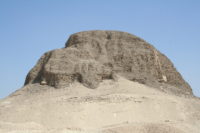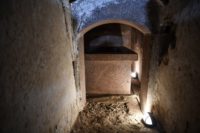 Egypt has opened the 4,000-year-old Pyramid of Lahun to the public for the first time. The mud-brick pyramid near the city of Faiyum was built for 12th Dynasty Pharaoh Senusret II who had done extensive works expanding water access and arable land in Faiyum during his reign (1897-1878 B.C.). He moved the royal necropolis to Lahun and built a workers’ quarter to house the people employed in the construction of the pyramid complex.
Egypt has opened the 4,000-year-old Pyramid of Lahun to the public for the first time. The mud-brick pyramid near the city of Faiyum was built for 12th Dynasty Pharaoh Senusret II who had done extensive works expanding water access and arable land in Faiyum during his reign (1897-1878 B.C.). He moved the royal necropolis to Lahun and built a workers’ quarter to house the people employed in the construction of the pyramid complex.
The pyramid was first excavated by Sir William Matthew Flinders Petrie in 1889. The pyramid’s contents had been thoroughly looted by then (Flinders Petrie actually found the royal burial chamber via a tunnel dug by tomb raiders and only discovered the actual entrance by working backwards from there), but he did discover a gold and inlay royal uraeus in a flooded chamber, a piece of pharaonic regalia lost by the plunderers on their way out.
 There are several unique features about this pyramid. Old and Middle Kingdom tombs typically placed the entrance on the north face, hidden behind a chapel. Senusret II had the chapel built in the usual location, but it concealed no entrance. Instead, the entrance corridor wasn’t in the pyramid; it was a vertical shaft under the tomb of a princess’ tomb 36 feet east of the pyramid’s south face. This was done to deter grave robbers, alas to little avail.
There are several unique features about this pyramid. Old and Middle Kingdom tombs typically placed the entrance on the north face, hidden behind a chapel. Senusret II had the chapel built in the usual location, but it concealed no entrance. Instead, the entrance corridor wasn’t in the pyramid; it was a vertical shaft under the tomb of a princess’ tomb 36 feet east of the pyramid’s south face. This was done to deter grave robbers, alas to little avail.
The pyramid was originally clad in white limestone with a black granite pyramidion topper. Some fragments of the latter have been found, but the limestone was stripped and reused for another construction project by 19th Dynasty pharaoh Ramesses II. Thousands of years of harsh elements did not improve its condition and extensive conservation had to be done to make it safe for visitors.
“The conservation work includes the removal of debris found inside the pyramid’s corridors and burial chamber and installing wooden stairs to facilitate its entrance,” Mostafa Waziri, General Secretary of the Supreme Council of Antiquities, said in a statement.
“It also includes re-installing the fallen stones in the hall and corridor to its original location after restoration, as well as restoring the deteriorated stones of its floor and installing a new lighting system.”